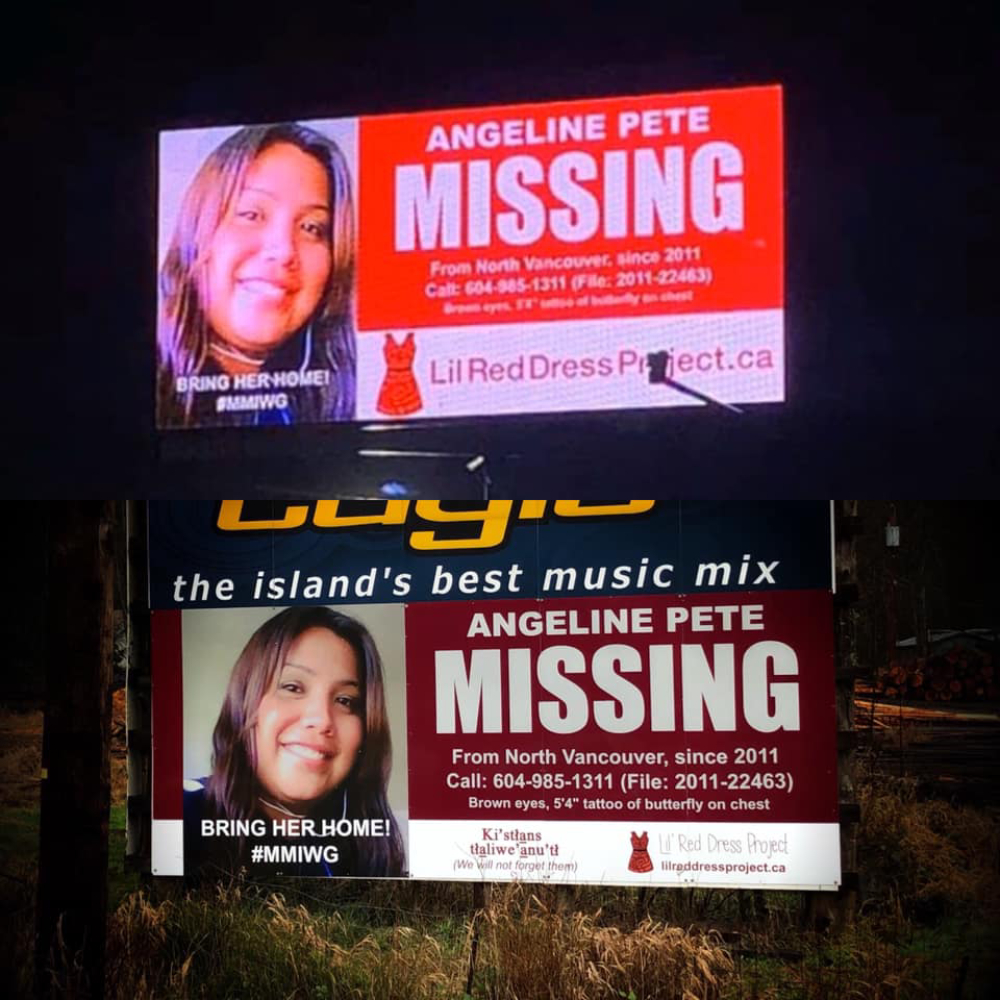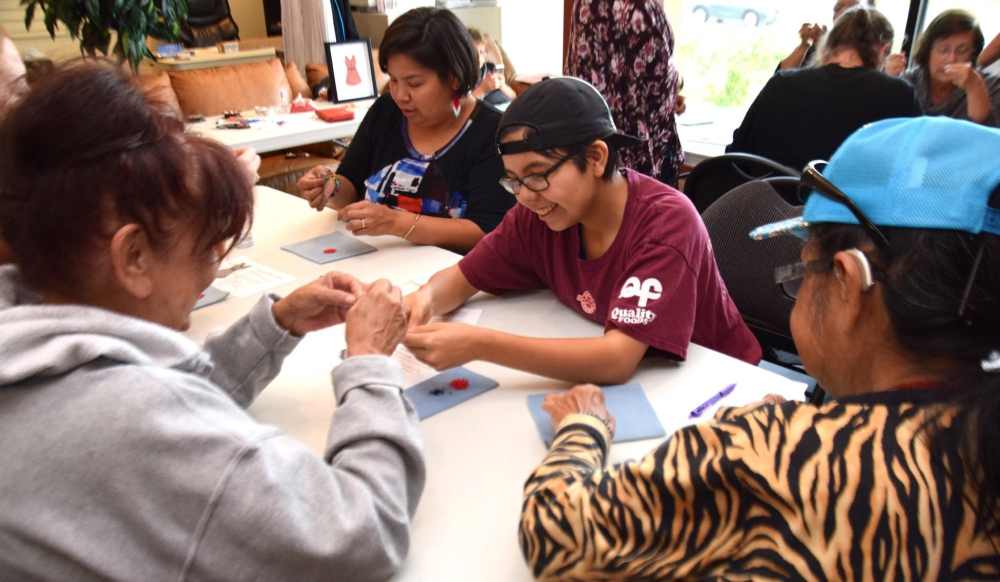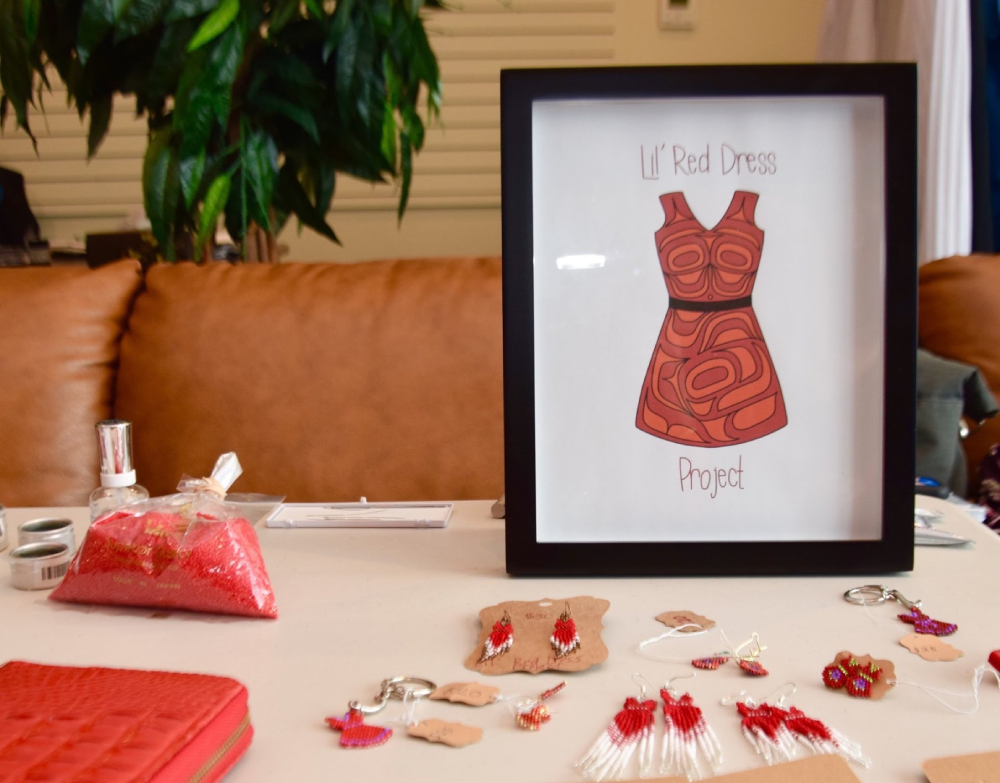Angeline Pete was 28 years old when she went missing from North Vancouver in 2011. Her family has searched for her ever since, campaigning to bring awareness about their missing loved one, hoping someone would come forward with a detail that could help them crack the case.
Now Pete is one of two missing Indigenous women being featured on billboards on Vancouver Island, thanks to two hardworking beaders who made pins and earrings to fund the effort.
The Lil’ Red Dress Project was founded by Carla Voyageur and Jeannine Lindsay of the Comox Valley, who with many volunteers have raised more than $15,000 since their first pin was sold on Sept. 23, 2018.
The billboards, which cost about $7,500, are part of the project’s effort “to bring awareness to missing and murdered Indigenous women and girls.”
Angeline Pete’s aunt Cary-Lee Calder praised the group.
“I’m very thankful to the Lil’ Red Dress Project,” she said. “I have huge respect to Carla and her team. And I’m thankful that billboard is going up.”
Calder’s sister, Molly Dixon, was Angeline’s mother. She died in 2017.
“We say that my sister died of a broken heart because she was searching for my niece and never found her,” said Calder. “She had a heart attack.”
Calder said the support from the Lil’ Red Dress Project is important because families struggle to search for loved ones or get answers.
“There’s nobody to communicate with in regard to, ‘How do you respond? How do you get the word out there? How do you even get something on a billboard like that?’” she said. “The resources needed for it aren’t there, supporting families trying to find their loved ones.”
Calder says the family frequently used posters to advocate for Pete, taking the search as far as Mexico when family members travelled there. Dixon was known throughout the Lower Mainland for her tireless advocacy in the name of her daughter, she added.
Calder believes the billboards could spark new leads. A number of people have already reached out to her since they first went up in late December, she said.

To help her own family heal from the loss, and to help other families dealing with grief over missing or murdered Indigenous women, Calder organized a gathering on the territory of the Kwakiutl First Nation (a Kwakwaka'wakw community) near Port Hardy last spring. Calder is Kwakwaka'wakw from the Quatsino First Nation herself.
Voyageur and Lindsay both attended, gaining insight and the respect and trust of Calder and her family. Their intention was to ensure everyone would be OK with having Pete’s picture on a billboard.
“We wanted to make sure that there wasn’t going to be a family member who was driving up island and all of a sudden saw their loved one’s photo on a billboard, and they didn’t know that was going to happen,” said Lindsay.
“Because that could be a lot of trauma... and a trigger. So, we made sure the entire family knew. That would be heartbreaking on our end to know that we caused harm to somebody,” she added.
Calder said she appreciated the sensitivity.
There are two signs currently posted. A digital billboard in Nanoose Bay near Nanaimo features both Angeline Pete and Lisa Marie Young, who went missing in 2002 at the age of 21 near Nanoose Bay. And a regular billboard in Black Creek, north of Courtenay, has a photo of Pete. Black Creek is on Kwakwaka'wakw territory, and Pete is Kwakwaka’wakw herself.
The inspiration for the project came because both Lindsay and Voyageur had noticed many advertisements over the years seeking help in finding a non-Indigenous woman missing for 25 years.
“The billboards were in groups of three, in like several locations, and it was quite profound to see them,” said Voyageur, who is Kwakwaka'wakw. “And through conversations with friends, we realized that... no Indigenous families we know could ever afford to put billboards up... for their loved ones missing,” she said.
They borrowed the idea of the red dress from the REDress Project by artist Jaime Black, which made it a symbol for missing and murdered Indigenous women and mixed it with their beading skills.
They began by producing beaded pins, and they were later given a pattern for beaded earrings, which also took off, said Lindsay. The items sell for $20 to $50 and produced the money needed for the billboards.


They’ve been shipped as far as Texas and Alaska and all across Canada, said Lindsay. The pair even held a Facebook contest a few months ago asking readers to share their page and gained the interest of people in Africa and France, she said.
Voyageur and Lindsay have recruited other helpers through the project’s educational seminars. They teach how to bead the pins and earrings and discuss the crisis, which the National Inquiry into Missing and Murdered Indigenous Women described as genocide.
They’ve been to universities, colleges, tribal councils, Aboriginal Friendship Centres and youth groups, said Voyageur. Some of the participants, like a Port Alberni women’s group, have become regular contributors, she said.
Due to the high cost, the billboards will only be up four months. But the pair hopes to generate more revenue to have the billboards up longer and feature other missing women from Vancouver Island, Lindsay and Voyageur say.
“It affects so many lives,” said Voyageur. “It’s an unfair world we live in. I have four daughters myself, so there’s always that underlying fear, every day... When you send them off to school, or when they’re on trips with people, or anything, right? It’s just a reality we have to live with.”
As for Calder, she thinks the billboards are a good start, but more can be done.
“I hope it impacts some change with regards to having to buy billboard space,” said Calder, noting the high cost. “And opens up dialogue of, ‘What are we going to do to bring our women home when they go missing?’
“We have an Amber Alert when a child goes missing... What do we do when a woman does?”
The Lil’ Red Dress Facebook page is available here.
There are also Facebook pages dedicated to Angeline Pete and Lisa Marie Young. ![]()
Read more: Indigenous, Rights + Justice
















Tyee Commenting Guidelines
Comments that violate guidelines risk being deleted, and violations may result in a temporary or permanent user ban. Maintain the spirit of good conversation to stay in the discussion.
*Please note The Tyee is not a forum for spreading misinformation about COVID-19, denying its existence or minimizing its risk to public health.
Do:
Do not: